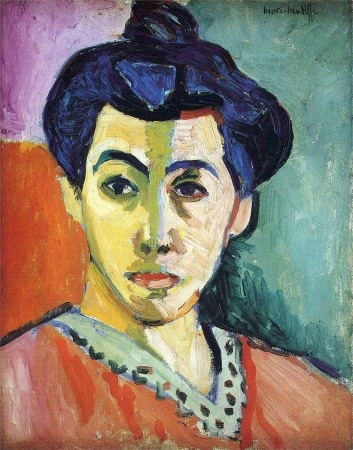|
Vibrant and graphic, Henri Matisse's Portrait of Madame Matisse (The Green Stripe) built upon the previous work of the Impressionists and Post- Impressionists and helped articulate the voice of a new movement, Fauvism. Spanning only a short time, Fauvism was an artistic movement in France from 1904 to 1908 that was marked by its bold and expressive use of color and simplification of shape. Painted in 1905, near the height of this short lived movement, Portrait of Madame Matisse (The Green Stripe) serves to illustrate the main stylistic hallmarks of the Fauvist movement even as it works to divorce itself from the academic stylings of the past. A portrait of Matisse's wife, the painting focuses on her face which is placed front and center of the composition. With cropping that is reminiscent of the Impressionist and photographic works which emerged onto the art scene years earlier, Portrait of Madame Matisse (The Green Stripe) creates its tension through the truncation of space surrounding Madame Matisse. She dominates the whole frame, physically touching all sides, from the top of her hair to her shoulders and lower chest. Like the Post-Impressionist Paul Cézanne, Matisse presses his subject close to the picture plane, almost into the viewer's space, in order to create a dynamic dialogue between the perceived dimensionality of Madame Matisse's figure and the flat surface of the painting. This emphasis on the two dimensional carries over into Matisse's portrayal of form. Though still representational, Matisse has simplified the forms of his painting into flat sections of color via the color patch technique which alternatively helps to build up the illusion of three dimensionality or break it down. The starkest example of this can be found in the juxtaposition of Madame Matisse's neck to the collar of her dress, where the roundness of the form gives way to the flat graphic area of color. Much like Paul Cézanne and Vincent Van Gogh, Matisse also utilizes impasto brushstrokes to help flush out his forms, curving them over the shifting planes of Madame Matisse's face - creating curvilinear strokes that inform the viewer as to its shape. Another element of Matisse's painting which helps to ascribe it to the Fauvist movement is Matisse's expressive use of color. Taking a page from Paul Gauguin's work, Matisse let his palette in Portrait of Madame Matisse (The Green Stripe) veer away from one which might be found in nature and instead used color in a way which he found visually pleasing. As a result, the color palette of Portrait of Madame Matisse (The Green Stripe) is bold, saturated, unnatural and expressive. Much like Post-Impressionist Georges Seurat, Matisse also included adjacent complimentary colors within his work which served to heighten the vibrancy, just as the competing sections of reds and greens in Portrait of Madame Matisse (The Green Stripe) stand out to the viewer's eye in a method of optical mixing. The overt green of the background balanced and highlighted the red of the dress, while the lighter green tint, which shapes the left side of Madame Matisse's face, pushes itself forward from the saturated red orange of the background. The juxtaposition of these two colors is a once jarring, yet innately pleasing, as they push the intensity of the color and bring a vibrancy to Madame Matisse. Henri Matisse was a driving force in the Fauvist movement, and with work like Portrait of Madame Matisse (The Green Stripe) it is not hard to see why. Like the Post-Impressionists he embraced, he expanded upon the competing values of two and three dimensionality within art, using them to create tension within his work. From Gauguin and Seurat, Matisse took expressive use of color and laid them down in the color patch technique, simplifying the shapes of Madame Matisse's head. He closely cropped the composition of his subject and allowed his impasto brushstrokes to read as paint upon the canvas, much like Van Gogh before him. All of these elements helped to support Matisse's avant-garde philosophy of making art for the sake of art, allowing a painting to simply be a painting - an embodiment of form, color and pattern for which the Fauvists were infamous.
6 Comments
Hayley
2/27/2018 07:42:40 am
Thamks
Reply
Phoebe
9/30/2018 04:03:05 pm
hell yeah this was frickin great thanks heaps x now i wont fail my hsc
Reply
dominik
2/22/2023 10:26:35 am
very very useful and informative.
Reply
7/19/2023 02:26:30 am
Cool. can I share this post to my blog? I'd appreciate it. Cheers!
Reply
Leave a Reply. |
AuthorCrystal has a MA in the History of Art from Courtauld Institute of Art as well as a BFA in Art History from the Academy of Art University. Archives
November 2017
Categories
All
|



 RSS Feed
RSS Feed